
Athens is a township in the United Counties of Leeds and Grenville in Eastern Ontario, Canada. It is located approximately 25 kilometres (16 mi) north of the St. Lawrence River, near Brockville, west of Addison, and about 90 kilometres (56 mi) south west of Ottawa. Formerly, it was a part of Yonge township before becoming Rear of Yonge and Escott with Athens as its own census division and finally, Athens township. The township consists of the town of Athens and a few other small communities.

Uxbridge is a township in the Regional Municipality of Durham in south-central Ontario, Canada.

Seaforth is a Southern Ontario community in the municipality of Huron East, in Huron County, Ontario, Canada.
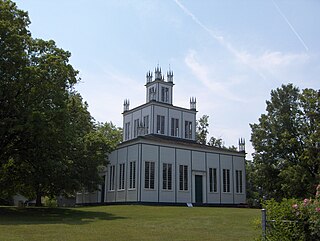
The Sharon Temple is an open-air museum site, located in the village of Sharon, Ontario, that was in 1990 designated as a National Historic Site of Canada. It is composed of eight distinctive heritage buildings and dwellings, and houses 6,000 artifacts on a 1.8 ha. site. The building is made available for public use such as tours, concerts, weddings, and special occasions by its current owner, the Sharon Temple Museum Society.
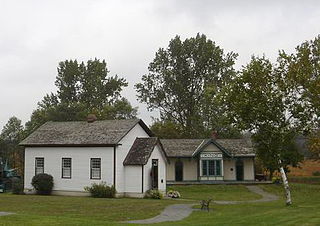
The King Heritage & Cultural Centre in King City, Ontario, Canada is a local history museum for the township of King at 2920 King Road.
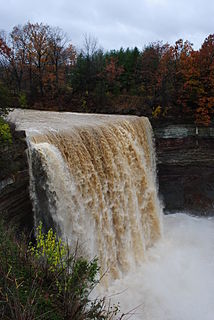
Ball's Falls also known as Balls Mills, Louthe Mills and Glen Elgin, is a historical ghost town located in what is now a part of Jordan in the Niagara region, Ontario, Canada, which dates back to the early 19th century. It is now preserved as a conservation area operated by the Niagara Peninsula Conservation Authority.

Port Elgin is a community in Bruce County, Ontario, Canada. Its location is in the traditional territory of the Saugeen Ojibway Nation. Originally named Normanton the town was renamed Port Elgin when it was incorporated in 1874, after James Bruce, 8th Earl of Elgin, a former Governor General of the Province of Canada.

The Township of Norwich is a municipality located in Oxford County in Southwestern Ontario, Canada. At the centre of the Township of Norwich is the Town of Norwich. The preferred pronunciation of the town name is NOR-witch, which differs from the pronunciation NORR-ij used for the city of Norwich, England. The origin of Norwich, Ontario, is more likely Norwich in upper New York State, the area from which the pioneering families emigrated in the early 19th century, where the community was known as Norwichville.
Samuel Moore, was notable as one of the civil leaders in the early years of the Province of New Jersey.

The Ashbridge Estate is a historic estate in eastern Toronto, Ontario, Canada. The property was settled by the Ashbridge family, who were English Quakers who left Pennsylvania after the American Revolutionary War. In 1796, as United Empire Loyalists, the family were granted 600 acres (240 ha) of land on Lake Ontario east of the Don River, land which they had begun clearing two years earlier.

Enoch Moore, son of Samuel Moore U.E. and Rachel Stone, married Elizabeth Smith, daughter of James Smith and Hannah Hawksworth, on March 30, 1803 in Old Holy Trinity Church, Lower Middleton, Annapolis County, Nova Scotia. Elizabeth was born on April 18, 1784 in Wilmot Township, NS, died on March 3, 1871 and was buried in New Milford Cemetery, Winnebago County, Illinois. Enoch was a direct descendant of one of New Jersey's early colonial officials, Samuel Moore.
Elias Moore was a Loyalist politician in Upper Canada. Born into a Quaker family in New Jersey just after the American Revolution began, he and his family eventually emigrated to Upper Canada. He later became a member of the Legislative Assembly of Upper Canada, and he is notable for being one of the first Quakers to take an elected seat in Canada.

South-West Oxford is a township in the Canadian province of Ontario, located within Oxford County. The township had a population of 7,664 in the 2016 Canadian census. A predominantly rural municipality, South-West Oxford was formed in 1975 through the amalgamation of Dereham and West Oxford townships and the village of Beachville. It is home to the Trillium Woods Provincial Nature Reserve, a wildflower protection area popular with tourists, which is particularly noted for its profusion of trilliums in springtime.

Otterville is a village in Norwich Township in Oxford County, Ontario, Canada. It is located on the Otter Creek with many historic features including Otterville Mill and Dam, Grand Trunk Station, African Methodist Episcopal Cemetery and a park.
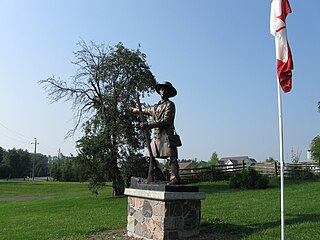
Jesse Lloyd was the founder of Lloydtown, Ontario and a leader in the Upper Canada Rebellion of 1837. Born in Springfield Township, Pennsylvania, he was the third son of Quakers William Lloyd and Susannah Heacock. The Lloyds, who were United Empire Loyalists, possibly came to Canada at Niagara in 1788 but soon returned to the United States. They likely immigrated permanently to Upper Canada in 1808. Upon arrival, they crossed the Niagara gorge and migrated north to settle in the 10th concession of King Township.

Built between 1822 and 1824, the St. Thomas Anglican Church, today called the Old St. Thomas Church, is one of the oldest structures in St. Thomas, Ontario The Church was continuously used between its founding and 1877. The church was made a designated heritage property in 1982.

The Heintzman House, also known as Sunnyside Manor Farm, is one of the oldest buildings in Thornhill-Markham, Ontario, where it sits on the crest of Bay Thorn Drive.

James Beach Moore was born into a Canadian Quaker family.

Lindley Murray Moore was an abolitionist, and educator.
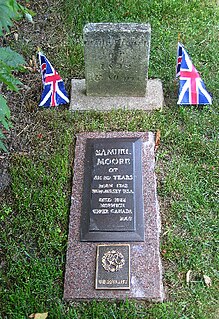
Samuel Moore (1742–1822) is notable as a leader in the early establishment of the Religious Society of Friends (Quakers) in Maritime Canada, and as the progenitor of a number of civic, religious and political leaders in both Canada and the United States.


















